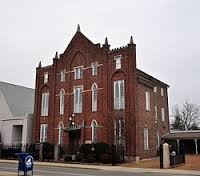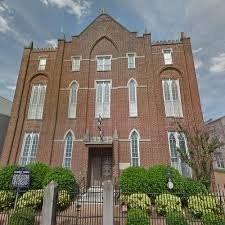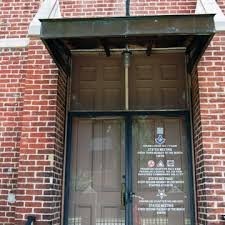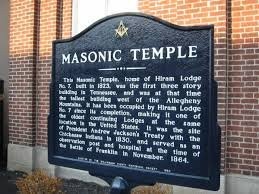Hiram Masonic Lodge No. 7
Introduction
Text-to-speech Audio
Built in 1823-1826, Hiram Masonic Lodge No. 7 is the oldest public building in Franklin and the first three-story building constructed west of the Allegheny Mountains. It was designed in the Gothic Revival style and is home to the longest, continuously operating Masonic lodge in the state.
The building was named a National Historic Landmark for its architecture and for its association with an important event of the 19th century. In 1830, representatives of the Chickasaw Indians and the delegates of the federal government, including President Andrew Jackson, met to negotiate the removal of the Chickasaw from Mississippi to Oklahoma. The Chickasaw agreed to leave, on condition that they approve the new lands provided by the government for them. However, they were not happy with the new lands and as a result, the treaty was never ratified. The document did, however, establish a pretext for white settlers to move into Chickasaw territory, and helped spur the eventual demise of Indian territory in the southern United States.
Images
Hiram Masonic Lodge No. 7 was built in 1823 and is home to the oldest operating Masonic lodge in the state (the lodge itself was founded in 1807).

Front of the Hiram Lodge

Part of the building's facade

Plaque commemorating the historic lodge

Backstory and Context
Text-to-speech Audio
Hiram Lodge No. 7, like all of the other original Masonic
lodges in the state of Tennessee, was chartered by the Grand Lodge of North
Carolina, which from 1803 to 1813 was known as the Grand Lodge of North Carolina and
Tennessee. A resolution to create the lodge was offered by Thomas Claiborne, a
Nashville lawyer, who became the lodge's first Grand Master. It was one of nine “Pioneer Lodges” in Tennessee established during
a meeting in December 1813. The Tennessee General
Assembly on November 14, 1817, authorized Hiram Lodge No. 7 to conduct the first legal lottery in
Tennessee to raise funds to build the Masonic Hall.
Constructed over the course of three years using handmade bricks, the building was completed in 1826 and became the first three-story building in the state and at the time the tallest building west of the Allegheny Mountains. It is also the oldest public building in the town of Franklin and the oldest Masonic Hall in continuous use in Tennessee. The fingerprints of the enslaved men, women, and children who molded the Hall’s bricks by hand are still visible. Future President Andrew Jackson became the 5th Grand Master of the Grand Lodge of Tennessee in 1822-23 and attended Hiram Lodge.
In addition to its distinctive three-story construction, Hiram Lodge No. 7 is notable for blending the flat Federal architectural style and the ornate Gothic Revival style. This style would not come into vogue in America until the 1840s. The structure is five bays wide and five deep. The front roof line is gabled in the center, battlemented to either side of the center gable and surmounted by five obelisk pinnacles.
In 1830, President Andrew Jackson was eager to fulfill his campaign promise of removing Indians from east of the Mississippi after the passage of the Indian Removal Act. The Chickasaw knew him well and respected him (they called him Sharp Knife), as they had fought together against the British during the Battle of New Orleans in 1815. He convinced the Chickasaw to agree to the treaty, knowing full well that white settlers would keep encroaching on their land. Although the treaty was never ratified, due to the Chickasaw's unhappiness with the Western lands the government had reserved for them, it was only a matter of time until white encroachment would force them and four other tribes to relocate. The government had little desire to protect Native Americans in territory coveted by white settlers. It was seven years after the Franklin treaty, in 1837, after signing the Treaty of Pontotoc, that the Chickasaw became one of the five tribes compelled to relocate to Oklahoma over the infamous "Trail of Tears." The removal of the Native American tribes allowed the vast expansion of the scope of slavery in America.
During the American Civil War, Hiram Lodge No. 7 was used alternately by Confederate and Union soldiers. Confederate spies would climb to the roof of the lodge to observe troop movements at Fort Granger, a nearby Federal post. During the Federal occupation of Franklin, the wooden furniture and floors were burned as firewood for heat. After the important Battle of Franklin, on November 30, 1864, the lodge served as a hospital for wounded Union soldiers. In 1912, forty-seven years after the end of the Civil War, the U.S. government finally paid reparations to the lodge for damage sustained by the building due to the occupation of Federal troops. Union graffiti written on the lodge’s inner walls was discovered during renovations to the building.
It is an active lodge with approximately three hundred members on the rolls. The Historic Franklin Masonic Hall Foundation offers an opportunity for teachers and students to experience preservation education. The site was designated a National Historic Landmark in 1972 and was listed in the National Register of Historic Places in 1973.
Constructed over the course of three years using handmade bricks, the building was completed in 1826 and became the first three-story building in the state and at the time the tallest building west of the Allegheny Mountains. It is also the oldest public building in the town of Franklin and the oldest Masonic Hall in continuous use in Tennessee. The fingerprints of the enslaved men, women, and children who molded the Hall’s bricks by hand are still visible. Future President Andrew Jackson became the 5th Grand Master of the Grand Lodge of Tennessee in 1822-23 and attended Hiram Lodge.
In addition to its distinctive three-story construction, Hiram Lodge No. 7 is notable for blending the flat Federal architectural style and the ornate Gothic Revival style. This style would not come into vogue in America until the 1840s. The structure is five bays wide and five deep. The front roof line is gabled in the center, battlemented to either side of the center gable and surmounted by five obelisk pinnacles.
In 1830, President Andrew Jackson was eager to fulfill his campaign promise of removing Indians from east of the Mississippi after the passage of the Indian Removal Act. The Chickasaw knew him well and respected him (they called him Sharp Knife), as they had fought together against the British during the Battle of New Orleans in 1815. He convinced the Chickasaw to agree to the treaty, knowing full well that white settlers would keep encroaching on their land. Although the treaty was never ratified, due to the Chickasaw's unhappiness with the Western lands the government had reserved for them, it was only a matter of time until white encroachment would force them and four other tribes to relocate. The government had little desire to protect Native Americans in territory coveted by white settlers. It was seven years after the Franklin treaty, in 1837, after signing the Treaty of Pontotoc, that the Chickasaw became one of the five tribes compelled to relocate to Oklahoma over the infamous "Trail of Tears." The removal of the Native American tribes allowed the vast expansion of the scope of slavery in America.
During the American Civil War, Hiram Lodge No. 7 was used alternately by Confederate and Union soldiers. Confederate spies would climb to the roof of the lodge to observe troop movements at Fort Granger, a nearby Federal post. During the Federal occupation of Franklin, the wooden furniture and floors were burned as firewood for heat. After the important Battle of Franklin, on November 30, 1864, the lodge served as a hospital for wounded Union soldiers. In 1912, forty-seven years after the end of the Civil War, the U.S. government finally paid reparations to the lodge for damage sustained by the building due to the occupation of Federal troops. Union graffiti written on the lodge’s inner walls was discovered during renovations to the building.
It is an active lodge with approximately three hundred members on the rolls. The Historic Franklin Masonic Hall Foundation offers an opportunity for teachers and students to experience preservation education. The site was designated a National Historic Landmark in 1972 and was listed in the National Register of Historic Places in 1973.
Sources
"Hiram Masonic Lodge No. 7." Hiram Masonic Lodge No. 7. Accessed December 12, 2017. http://www.hiram7.org.
Levy, Ben. "Hiram Masonic Lodge No. 7." National Park Service - National Register of Historic Places Nomination Form. November 7, 1973. https://npgallery.nps.gov/GetAsset/64cbbcf9-75b2-418a-982e-ceb130a56dfd.
"Hiram Masonic Lodge No. 7." National Park Service: NPGallery Digital Asset Management System. https://npgallery.nps.gov/AssetDetail/NRIS/73001859.
"Our Story." Historic Franklin Masonic Hall Foundation. https://hfmhfoundation.org/story/#hall.
"Education." Historic Franklin Masonic Hall Foundation. https://hfmhfoundation.org/learn.
“A Brief History of Hiram Lodge No. 7 F&A, Franklin, Tennessee.” Tennessee Lodge of Research. http://tnlor.org/?p=64.
Robinson, Carole. “Historic Franklin Masonic Hall Hiram Lodge No. 7.” Williamson Herald. 11/22/17. http://www.williamsonherald.com/image_1b6eaf20-d00b-11e7-ab1d-1339edf15010.html.
Hinds, Andrea. “Hiram Masonic Lodge No 7 to Receive Historic Landmark Plaque”. Williamson Source. 5/13/15. https://williamsonsource.com/hiram-masonic-lodge-no-7-to-receive-historic-landmark-plaque.
Levy, Ben. "Hiram Masonic Lodge No. 7." National Park Service - National Register of Historic Places Nomination Form. November 7, 1973. https://npgallery.nps.gov/GetAsset/64cbbcf9-75b2-418a-982e-ceb130a56dfd.
"Hiram Masonic Lodge No. 7." National Park Service: NPGallery Digital Asset Management System. https://npgallery.nps.gov/AssetDetail/NRIS/73001859.
"Our Story." Historic Franklin Masonic Hall Foundation. https://hfmhfoundation.org/story/#hall.
"Education." Historic Franklin Masonic Hall Foundation. https://hfmhfoundation.org/learn.
“A Brief History of Hiram Lodge No. 7 F&A, Franklin, Tennessee.” Tennessee Lodge of Research. http://tnlor.org/?p=64.
Robinson, Carole. “Historic Franklin Masonic Hall Hiram Lodge No. 7.” Williamson Herald. 11/22/17. http://www.williamsonherald.com/image_1b6eaf20-d00b-11e7-ab1d-1339edf15010.html.
Hinds, Andrea. “Hiram Masonic Lodge No 7 to Receive Historic Landmark Plaque”. Williamson Source. 5/13/15. https://williamsonsource.com/hiram-masonic-lodge-no-7-to-receive-historic-landmark-plaque.
